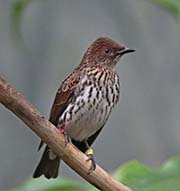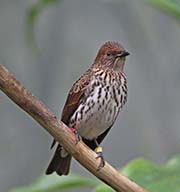Violet-backed Starling - Cinnyricinclus leucogaster
| Length | |
| Weight | |
| Clutch Size | |
| Chicks at birth | |
| IUCN Conservation Status | |
Continents: |
The Violet-backed Starling is also known as the Amethyst Starling and the Plum-colored Starling. There are three recognized subspecies. It is one of the world's 114 starling species. The male is a deep iridescent violet set off by a white breast with black splotches. the feet and bill are black. The female is sexually dimorphic. The brown head and back and white underparts and are heavily streaked with dark brown. Juveniles are similar to the females.
Diet: Amethyst Starlings eat fruit and insects. Insects are caught by gleaning them off of trees or catching them in flight. They will flock to and consume many termites when the termites swarm.
Courtship: Amethyst Starlings are believed to mate for life. They lived in small flocks until mating season.
Nesting: They build their nests in tree holes that are high off the ground, river banks holes, hollow fence posts. The nests are lined with dung, leaves and other plant material. 2-5 eggs are laid and incubated by the female. Both parents feed the altricial (born helpless) chicks insects.
Habitat and Range: Amethyst Starlings are found in Africa south of the Sahara. Amethyst Starlings inhabit mountain cliffs, savannah woodland, gardens, bushland near fruit trees.
Vocalization: No information found.
Plumage/Molt: Amethyst Starlings do not have an alternate or breeding plumage. Their molt cycle is unusual because it can vary between individuals. Some breed, molt, and then migrate. Others molt, migrate and then breed.
Migration: The various maps show some migration but most are year-round residents.
Bibliography:
- http://en.wikipedia.org The Free Encyclopedia, Accessed June 2012
- http://birdlife.org BirdLife International, Accessed June 2012
- http://www.birdforum.net Birdforum: the forum for wild birds and birding, Accessed June 2012
- http://www.sabisabi.com/wildfacts/ Sabi Sabi Wild Facts, Accessed June 2012
- http://www.riverbanks.org/subsite/pact/sturnids.pdf The Sturnidae Husbandry Manual and Resource Guide by Greg Bockheim and Susan Congdon, Accessed June 2012





